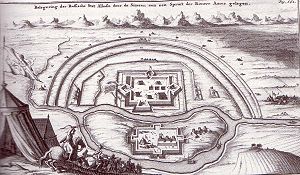
Back النزاعات الحدودية الصينية الروسية Arabic রুশ–চীন সীমান্ত সংঘর্ষ Bengali/Bangla Rusko-čchingská válka Czech Conflictos fronterizos sino-rusos Spanish درگیریهای مرزی روسیه و منچو Persian Conflit frontalier sino-russe French Konflik perbatasan Tiongkok–Rusia ID 清露国境紛争 Japanese 청-러시아 국경 분쟁 Korean Манж-Оросын хилийн будилаан Mongolian
| Sino-Russian border conflicts | |||||||
|---|---|---|---|---|---|---|---|
 Qing Empire forces storming the fort of Albazin | |||||||
| |||||||
| Belligerents | |||||||
|
Qing dynasty Joseon | |||||||
| Commanders and leaders | |||||||
| |||||||
| Strength | |||||||
| 2,000 men[1] |
| ||||||
| Casualties and losses | |||||||
| c. 800 men[2] |
| ||||||

The Sino-Russian border conflicts[3] (1652–1689) were a series of intermittent skirmishes between the Qing dynasty of China, with assistance from the Joseon dynasty of Korea, and the Tsardom of Russia by the Cossacks in which the latter tried and failed to gain the land north of the Amur River with disputes over the Amur region. The hostilities culminated in the Qing siege of the Cossack fort of Albazin in 1686 and resulted in the Treaty of Nerchinsk in 1689 which gave the land to China.
- ^ a b CJ. Peers, Late Imperial Chinese Armies 1520-1840, 33
- ^ China Marches West: The Qing Conquest of Central Eurasia By Peter C. Perdue Published by Harvard University Press, 2005
- ^ Wurm, Mühlhäusler & Tryon 1996, p. 828.